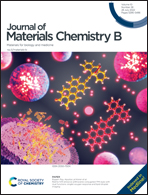Development of a single-molecule biosensor with an ultra-low background for the simultaneous detection of multiple retroviral DNAs†
Abstract
Human T-cell lymphotropic virus type I and type II (HTLV-I and HTLV-II) are the two most prevalent subtypes of HTLVs, and they usually infect individuals asymptomatically and may induce various diseases. Herein, we develop a single-molecule biosensor with an ultra-low background for the simultaneous detection of multiple retroviral DNAs. This biosensor is constructed by immobilizing two types of signal probes (i.e., signal probes 1 and 2) onto the surface of magnetic beads (MBs) through specific biotin–streptavidin interactions. The presence of HTLV-I DNA and HTLV-II DNA will initiate the RNase H-assisted cyclic cleavage of signal probes, inducing the release of Cy3 and Cy5 fluorophores from the MBs. After magnetic separation, the Cy3 and Cy5 fluorophores can be directly quantified by single-molecule detection, with the Cy3 signal indicating HTLV-I DNA and the Cy5 signal indicating HTLV-II DNA. This biosensor enables the all-in-one and simultaneous detection of HTLV-I DNA and HTLV-II DNA under isothermal conditions, greatly simplifying the operation procedures and reducing the assay time. Due to the high amplification efficiency of RNase H-assisted target recycling, the ultra-low background resulting from magnetic separation, and the intrinsic high signal-to-noise ratio of single-molecule detection, this biosensor exhibits high sensitivity with a detection limit of 66.1 aM for HTLV-I DNA and 82.8 aM for HTLV-II DNA. Moreover, it can be applied for the discrimination of HTLV-positive cells from HTLV-negative cells, and even simultaneously quantify endogenous HTLV-I DNA and HTLV-II DNA at the single-cell level. Furthermore, this biosensor can be extended to detect other nucleotide molecules by rationally designing signal probes, providing a universal and powerful tool for clinical diagnosis and biomedical research.



 Please wait while we load your content...
Please wait while we load your content...